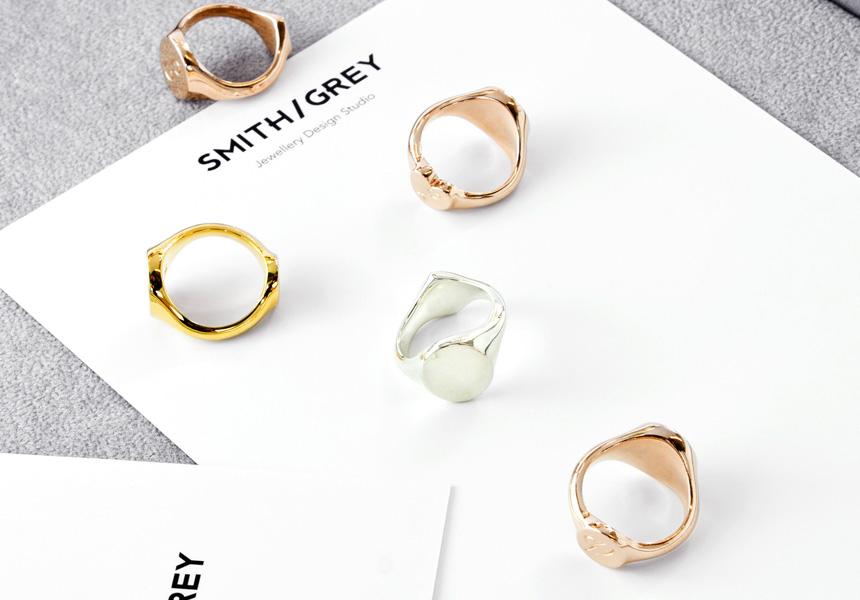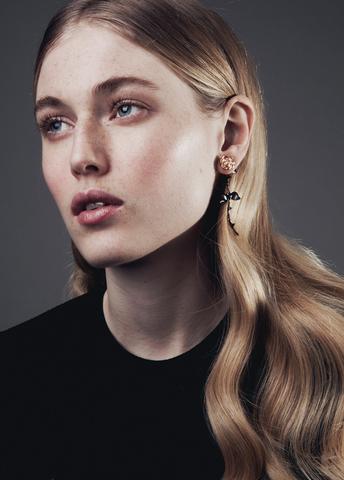A little introduction to jewellery metals
Jewellery is created using a wide array of metals and alloys. There are only 86 known metals, however of those, only a few are being used in jewellery making due to their properties and qualities for craft processes and wearability.

Sterling silver
Sterling silver is an alloy of silver containing 92.5% by weight of silver and 7.5% by weight of other metals. Sterling silver is a very popular jewellery metal. It is malleable and easy to work with and also comfortable to wear. Its surface and look varies depending on its finish: it can be polished to a luster shine or oxidised to achieve a dark, matte finish.

Gold plated silver / Gold vermeil
Gold plated silver is made of solid silver that is covered in a thin layer of precious gold. The thickness of the gold layer may vary: Rings are usually plated more heavily than for example earrings, as they are more heavily used. The terms ‘Gold Vermeil’ marks plated pieces that are more heavily plated than usual plated pieces, to guarantee longer durability of the plating.

Gold
Gold is the most popular jewellery metal and a popular choice for signet, wedding and engagement rings. When choosing gold, there are two things to consider: First, which carat gold to choose from and second, which gold colour to go with.

Platinum
Dense and durable, platinum is considered to be one of the most luxurious and prestigious precious metals. Its naturally white colour is one of a kind, making it the perfect accompaniment to diamonds and coloured gemstones. Due to its 95% purity, platinum does not oxidise in the air at any temperature, keeping its lush bright colour consistent and untarnished.

9 Karat
Contains 37.5% pure gold; it is the most affordable type of gold jewellery and has a lighter hues than higher carats. Its alloy contains a higher amount of other metals, making it stronger and more durable.
14 Karat
Contains about 58.5% pure gold and features a warm yellow hue whilst still being more affordable than 18k gold.
18 Karat
Contains 75% gold, with the remaining part made up of other more durable metal alloys used to add colour and strength. Its tone is warmer and brighter than 14 or 9 karat gold and valued higher.
Yellow gold
The most popular gold colour. Depending on its karat, the hue and intensity of yellow gold varies from light yellow to a more intense, yellow golden tone.
Rose gold
This gold alloy combines gold with copper to create a golden metal with a rosy hue. Rose gold is a popular choice these days and works well with white and blue stones.
White gold
White gold is an alloy that combines gold with white metals, such as zinc, nickel, platinum and silver. White gold usually requires rhodium plating for a nice and bright finish.
A little introduction to gemstones
A gemstone is a piece of natural occuring mineral crystal, which, after being cut or polished, is used for persoanal adornment such as jewellery.
Sometimes certain rocks (such as lapis lazuli) or organic materials that are not mineral (such as amber), are also used in jewellery making despite and therfore often referred to as gemstones as well.
Gemstones may be characteristed by their hardness (Mohs’ scale: diamonds the hardest, pearls the softest), colour or rarity.
Gemstones can be cut and polished to achieve a certain shape and luster. Faceted cuts found in round or pear shapes highlight the gemstone’s reflective qualities, while cuts such as cabochons make the stone appear softer and focuses on its colours or inclusions.

Diamond
Diamonds, probably the most famous of all gemstones, are very unique in many ways. Being the hardest substance on earth, their unique spark makes them a treasured and obvious choice for engagement rings. Most Diamonds used in jewellery are colourless, with faint champagne, brownish or yellow versions as an alternative. Natural, vividly coloured Diamonds, know as “fancies”, are extremely rare, making them one of the most valuable substances known on earth.

Ruby
Famed for its lustrous, bright red colour, Rubies are hard, durable and rare gemstones. Large colourless rubies are even rarer than the famous Diamonds. Rubies are technically red Sapphires, as they derive from the same mineral, named Corundum. Rubies and Sapphires are therefore identical in all properties except for its colour. Due to its special red tone and allure, it has always been regarded as an individual gemstone, and never as a form of Sapphire.

Tanzanite
Intriguingly coloured from blue to violet and seemingly changing colour in different light conditions, Tanzanite has only been discovered and used since 1967. Tanzanite is named after its country of origin, Tanzania, where it can only be found in the Arusha region. Tanzanites are striking gemstones, making them a wonderful alternative when looking for a blue stone.

Emerald
A green variety of Beryls, Emerald is the most sought after and valuable green gemstone. Durability, rarity and its beautiful, intriguing green colour makes Emerald one of the most expensive gemstones. Its value is defined by the intensity of its colour, with deep green being the most valuable version. Very pale emeralds are not called Emeralds but “Green Beryl”. When heat treated, their colour can be turned blue and transformed into Aquamarine.

Aquamarine
Being named after the latin phrase “water of sea”, Aquamarine is the blue variety of Beryl. Its colour ranges from a faint light blue to a bluish-green tone, with lighter coloured hues being the most common type. As mentioned above, pale Beryls can be transformed into Aquamarine if heated to 400ºC / 750ºF. Aquamarine is affordable in lighter colors, deeper colors can command higher prices.

Tourmaline
The allure and beauty of Tourmaline is one-of-a-kind. Occuring in all colours, but mostly pink, red, green, blue and mutilcoloured. Tourmaline is actually not a single mineral, but a group of multiple minerals similar in their chemical and physical qualities. Famous watermelon coloured Tourmaline in green and pink is one of the most beautiful, coloured gemstones.

Amethyst
Considered valuable since ancient times, Amethyst is one of the most popular gemstones. Interestingly, its name derives from the Greek "amethystos", meaning "not drunken", as Amethyst in antiquity was thought to ward off drunkenness. Amethysts are considered to be obtainable and fairly inexpensive due to large amounts of deposits discovered since the 1800's. Its colours range from pale to dark purple.

Blue sapphire
When it comes to blue gemstones, Sapphire is the most precious and valuable blue gemstone. Its excellent colour tones and luster, durability and hardness makes it a very desirable gemstone. Sapphires derive from the mineral Corundum and come in different colours, such as pink or colourless.

Pink sapphire
The pink variety of the mineral Corundum, pink sapphires range in hue and tone from demure light peach to hot bubble gum pink, making them the perfect choice for pink gradient effects.

Tsavorite
Oroginating in Africa, Tsavorite is a name for the emerald-green variety of Grossular Garnet. One of the most popular and expensive Garnets, the gemstone was first discovered in Tanzania in the 1960’ and later in Kenya, near Tsavo National Park, a wildlife preserve in the African Serengeti, where its name derives from.

Moonstone
Named for its glowing and unique colour that resembles moonlight, Moonstone is a member of the feldspar group, especially Orthoclase and Oligoclase. Its play of colour, known as adularescence, causes an effect of floating light or sheen. This mesmerizing, glowing effect is actually caused by structural anomalies within the crystal formation.

Topaz
Topaz is an ideal gemstone for jewellery making and a popular gemstone due to its good hardness, array of beautiful colours combined with a relative abundance. Orange-yellow Topaz are the most valuable, especially the deeper coloured varieties. Blue hued Topaz is the most commonly used colour, and mostly achieved due to heat treating to achieve various depths of blue.

White pearls
Pearls are organic, round or irregular shaped gems, generally formed within the soft tissue layer of oysters or mussels. Since antiquity, pearls have been highly valued due to the difficulty of sourcing them in early times. Nowadays, pearls can be cultured and farmed easily using freshwater mussels.

Peacock pearls
Pearls referred to as peacock are pearls with a dark blue-grey to green-tray colour, often with a pink or purple overtone. Their colour might vary slightly from pearl to pearl. Pearls can be naturally coloured (Tahitian) or dyed to look that way (cultured freshwater).

Want to know more?
If you would like to hear more about bespoke jewellery with gemstones then please get in touch and we will be happy to assist you.

